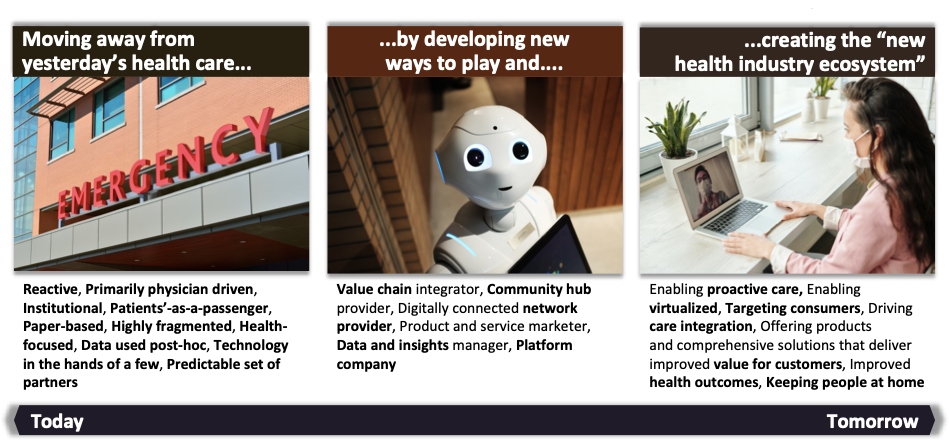By Alexander Bedenkov, Andrey Ipatov, and Ryan James Bate
What do people want from their health care? A new pill? Not really… What they really want is to live long, healthy disability-free lives, and then die fast and painlessly. The reason that what people get is different from what they need lies in the multiple healthcare challenges we face at the moment, including but not limited to fragmented, inflexible health systems, inequity of access and outcome, unsustainable financing, inability to adapt to ongoing technology development, and the role of the patient as passenger rather than driver.
To summarise our current healthcare status in one sentence, as mentioned by Anne Wojcicki, 23andMe CEO: ‘it seemed wrong that no one made money if we stayed healthy but lots of companies would make money if we got sick…’
So how can we improve healthcare? How do we create a new patient-centred and fully-integrated healthcare ecosystem, moving away from yesterday’s fragmented and volume-based system to a value-based model?
Potentially, we can address the challenges through partnerships, through digital innovation, increasing patient responsibility, pushing for greater effectiveness (rather than efficiency alone) and improved combination of public and private health systems together. A high priority is to redefine industry boundaries and business models, as well as to interweave technology, healthcare, socioeconomics and leadership evolutions into a new shape for healthcare.
Figure 1. The new health industry ecosystem and “ways to play”

Source: Author’s adaptation from The new health industry ecosystem – What’s your “way to play?, in strategy&, PwC. Royalty-free images from Pexels (here, here, and here)
A recent phenomenon is the case of companies across all industries transitioning from product-based to platform-based business models, as has been adopted by the pharmaceutical industry with the number of so-called “pill to platform” publications growing each year accordingly.
Several companies have successfully made giant leaps and transitioned to a platform based models already:
- Ford went from an automaker to a platform company delivering mobility
- Lego shifted from a toymaker to a platform for learning through play
- Sberbank evolved from a bank to a do-it-all tech platform.
In addition, we have a set of new technologies, or rather new applications of existing technology, that have over the past five years radically improved the efficiency of some industries: the world’s largest taxi firm, Uber, owns no car; the world’s most popular media company, Facebook, creates no content; and the world’s most valuable retailer, Alibaba, carries no stock. Something big is going on and it is obvious that the healthcare industry’s time has come (see Figure 1, above).
Healthcare designed around us
Ground-breaking digital technology and the convergence of escalating priorities and unmet needs in wellness (eg, nutrition, weight management, physical activity, managing and sharing personal health data and consumer-genomics), medical (chronic respiratory disease, telemedicine, diabetes, cardiovascular disease and cancer) and consumer (digital/mobile, personalised, social media, customer support, reminders and education) categories in healthcare are transforming the landscape, and radically redefining the possibilities of tomorrow.
As a result, healthcare will be designed around us: patient-centred, with wearables at the forefront, digitised and with decentralised doctors and evolved healthcare provision.
The pharmaceutical industry is moving from a traditional “pill” model to a “platform” (pill + service + data + software) model to deliver value beyond treating illness and to start facilitating wellness. By establishing fully integrated, partner-based patient-centred ecosystems, companies are contributing to disease prevention, risk awareness, post-treatment and wellness.
But this goes beyond the classic diagnostic and treatment interventions, instead seizing the unique opportunity through an innovative, well-coordinated and implementable set of actions that bring together the expertise, support and collaboration of diverse stakeholders. In other words, to see patient wellness and illness as interconnected elements within a dynamic equilibrium – helping people stay well and live fully, as well as manage disease.
The goalposts are moving. Extending a patient’s life by months through incremental improvement in therapy may become a less enticing goal in the future. The death sentence that the term ‘terminal illness’ brings may not be seen as so definitive.
Reimagining patient experiences
In this transformational journey, our emerging markets team decided to follow an unusual and, based on lessons learned during the implementation phase, challenging direction: to create and strengthen partnerships that accelerate innovation, increase access to healthcare and improve outcomes for society using the concept of ‘health innovation hubs’.
We constructed a network of both physical locations and virtual partnerships that work to solve, scale and showcase innovative and holistic health solutions around the full end-to-end patient journey – a key step forward in our commitment to delivering truly patient-centric disease management.
These innovation clusters of expertise, ambition, partnership and investment around digital, R&D and academia helps us reimagine how we can improve patient outcomes. And, vitally, to deliver it.
Another critical pillar to enable our transition to a platform company is the way we engage patients, which needs to be radically transformed. Patient engagement is not just patient communication or education – nor is it simply implementing online patient portals, but active collaboration to design, manage and achieve positive outcomes together.
Fundamentally we believe that the pharmaceutical industry shares a collective responsibility with healthcare providers, regulators, governments, payers, civil society, entrepreneurs and other stakeholders to work together and enable as many patients as possible to access innovative healthcare solutions.
The pharma industry are uniquely placed to leverage our scientific expertise, tools and capabilities to shape medical practice, elevating the healthcare environment and accelerating innovation. We aspire to readdress patient experiences and help people to live long healthy disability-free lives. This is more impactful than a new a pill only!
♣♣♣
Notes:
- This blog post expresses the views of its author(s), not the position of LSE Business Review or the London School of Economics.
- Featured image by CDC on Unsplash
- When you leave a comment, you’re agreeing to our Comment Policy





